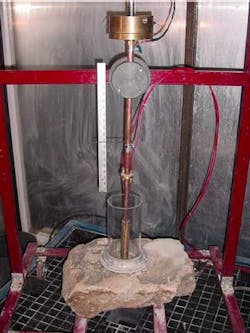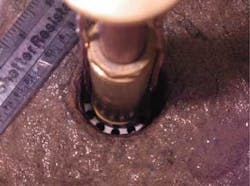DRILLING TECHNOLOGY: Plasma-channel process used to drill 1-2 in. micro-boreholes
Electrical engineers at the University of Strathclyde (UK) were awarded £146,000 to further develop a new oil drilling technique that will make exploration cheaper and ultimately increase extraction of more oil from every well. As oil prices fluctuate and North Sea reserves are depleted, the oil and gas industry is constantly looking for new ways to maximize production at least cost. The Oil Industry Task Force (OITF) has estimated that as much as 1.3 billion bbl of oil could be retrieved from existing wells, if new recovery techniques were available.
A research group of the University of Strathclyde's Department of Electronic and Electrical Engineering has developed a new drilling technique that has the potential to provide the required efficiency. The device, led by Professor Scott MacGregor and Dr. Steven Turnbull, uses high voltage pulses to produce plasma-channel formation inside the rock, ahead of the drill region. The extremely rapid expansion of this plasma channel within the rock, which occurs in less than a millionth of a second, causes the local region of the rock to fracture and fragment. The permeability of the rock should be unaffected by this process.
The research project is aimed towards developing a low cost drilling technique that can be deployed using wireline or coiled tubing. It is primarily designed for drilling "micro-boreholes," between 1 in. and 3 in. in diameter. Ultimately, we see that the technology would be used for remedial drilling in existing wells, improving the well efficiency through sidetrack drilling, and also for less expensive exploration through narrow mono-diameter borehole creation.
We are currently six months into an 18-month development program and are still at the laboratory stage, successfully drilling 40-50 cm deep holes of 4 cm diameter through water-saturated sandstone samples. Fluid is circulated to remove drill cuttings and due to the nature of the drilling process, the cuttings are very fine, typically 300 microns or smaller. This minimizes fluid flow requirements. The program is geared towards on-land field trials to demonstrate deeper hole drilling.
The plasma-channel technique represents a major advance in drilling through its portability and optimum use of input energy. In addition, because the plasma-channel process generates small holes of only 1-2 in. in diameter, damage to the seabed is greatly reduced, compared to that of conventional drilling.
The underpinning technology behind the plasma-channel drilling process is that of high-voltage pulsed power. The university is an internationally recognized center of excellence for Pulsed Power Technology.
The group was formally awarded the funding by Scottish Enterprise to continue their work in plasma-channel drilling. It is predicted that the new technique will be exploited commercially. The economic pressures are requiring the oil and gas industries to focus on the development of new technologies that will reduce production costs, allow existing oil wells to provide greater yields and ensure that adverse environmental effects are minimized. Plasma-channel drilling has the potential to address all of these issues.
Successful development of this technology is likely to have a major impact not only on the Scottish Oil and Gas Industry but also the world. Estimating the increase in recovery from existing wells, the benefit to the Scottish economy will be even greater if the 4.3 billion bbl of oil estimated to exist in new reserves can be fully exploited.
Dr. David McBeth, Deputy Director of Strathclyde University's Department of Research and Consultancy, stated that many companies now recognize that small-diameter holes represent the preferred option for oil exploration and retrieval because of the resultant big reduction in drilling costs and in environmental impact. Plasma-channel drilling can provide this option and become the technology of the future for oil and gas exploration and recovery.



